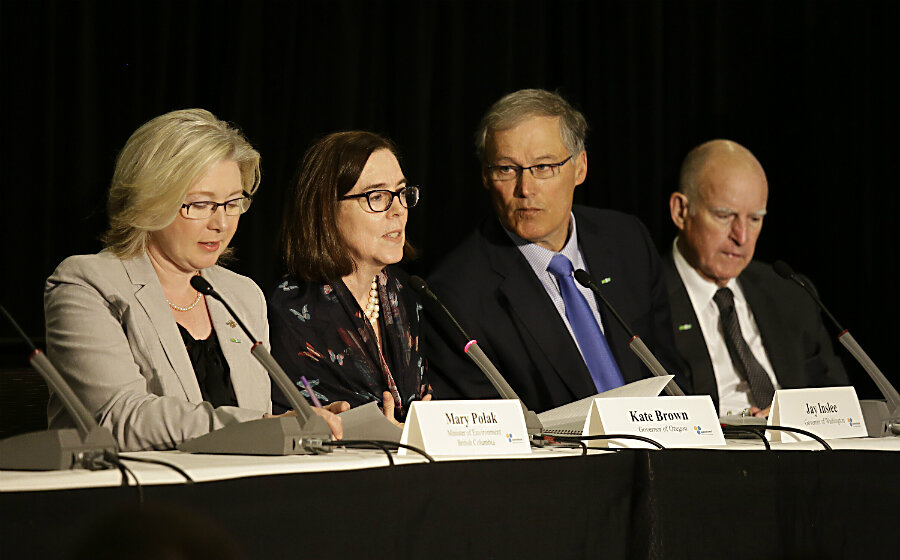To reach carbon-cutting goals, a quest for greener appliances
Loading...
The world has agreed to try to rein in the biggest causes of climate change – but it won’t get there without some serious commitment and investment on the energy front.
That was the message this week as global energy ministers and business leaders met in San Francisco for a Clean Energy Ministerial representing nations producing the bulk of global carbon emissions.
The meeting highlighted progress, such as falling costs and the rising deployment of renewable sources like solar and wind globally. But it also pointed to big hurdles that remain.
In Paris last December, after all, countries pledged to reduce carbon emissions enough to keep global warming under 2 degrees C above pre-industrial temperatures. That won’t be easy, given the already big rise in atmospheric greenhouse gases, still-growing human populations, and economic development that will boost the world’s energy use per person.
One of the main focuses of the San Francisco meeting was on how to make everyday household appliances more energy efficient. Various commitments showcased the way the world's largest emitters – including businesses and nonprofits, as well as governments – intend to meet the Paris promises:
•XPRIZE said it will offer incentives for innovations to provide energy abundance for all, including off-grid populations remote from cities.
•India’s energy minister described the nation’s lighting transition toward LED bulbs. Thanks to the massive deployment, in just 20 months, the cost of LED lightbulbs in India dropped by around 83 percent. Most important, the initiative is expected to save around 277 terawatt hours of electricity and cut around 254 million metric tons of carbon emissions between 2015 and 2030.
•Ingersoll Rand commits to spending $500 million by 2020 for boosting efficiency and lowering the greenhouse footprint of its heating, ventilating, and air conditioning (HVAC) products.
•A new Energy Management Campaign is promoting sustainable energy practices in businesses and facilities. The standard for certification is known as ISO 50001, so the announced target is, cleverly, 50,001 facilities by 2020. The group, led by the US and Mexico and Canada, says projected annual emissions saved could end up equaling the removal of 215 million passenger vehicles from the road per year.
The Clean Energy Ministerial dates back to 2010 as a place for world leaders and clean energy gurus to swap ideas. But because of the historic Paris climate treaty, this week's "CEM7" meeting came with extra urgency.
“As one of the first major gatherings of clean energy leaders since [the treaty], CEM7 is a key tool needed to implement the clean energy goals made in Paris,” US Energy Secretary Ernest Moniz said during the conference. “CEM and the commitments made today demonstrate how the United States and our global partners can speed the deployment of clean energy technologies to meet our climate goals, grow low-carbon economies, and strengthen our energy security.”
Already, in Paris, the Clean Energy Ministerial launched a Global Lighting Challenge to push the sale of efficient, LED lights to 10 billion as quickly as possible.
So far, India has taken the lead on this initiative. It recently became the world’s first country to set quality and performance standards for LED lights. The country’s goal is to use around 770 million LED bulbs and 35 million LED street lights over the next 3 years.
Other countries, such as Australia, Germany, Mexico, and Sweden, have set out similar goals.
“During the last years we have seen impressive innovations in the field of lighting products and solutions,” Sweden’s energy minister Ibrahim Bayla said Thursday. “New lighting creates new opportunities in our societies and with multiple benefits. Sweden wants to support the transition to universal access of high-efficient and high-quality lighting, which is why we join this race with other CEM partners to realize the efficiency potential that exists in Sweden and the rest of the world.”
With summer-like temperatures already on the thermometer in much of the world, another focus is how to develop low-carbon cooling technologies, such as energy efficient air conditioners.
"Access to cooling is at the heart of opportunity, health, and prosperity, but the challenge we have before us is how to deliver that cooling sustainably to more people," Gabrielle Dreyfus, the US lead for the Clean Energy Ministerial’s Super-efficient Equipment and Appliance Deployment (SEAD) Initiative, said Thursday.
Experts estimate that around 25 billions tons of carbon emissions could be saved over the next 15 years if the average air conditioner became around 30 percent more energy efficient.
If all of the countries present at the ministerial adopt clean technologies like renewable power and energy efficient appliances, experts say it could have a big impact. The 23 countries present at the ministerial represent around 75 percent of carbon emissions worldwide, and 90 percent of investment in clean energy technology. China, the United States, the European Union, and India are currently the world’s largest carbon emitters, but they are also some of the countries most involved in promoting clean energy, and most committed to cutting emissions.
China and the European Union have already pledged to host the two subsequent CEM conferences.
“Clean energy is the future,” Carlos Moeda, the EU commissioner for research, science, and innovation, said Thursday. “International cooperation is needed to address the global challenge of the energy transition and CEM provides the platform for coordinated action.”








